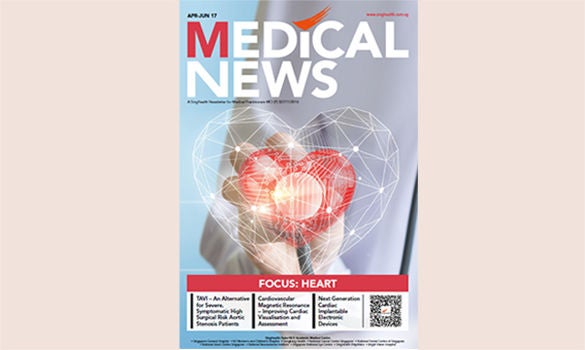
Cardiovascular imaging assesses the structures and function of the heart non-invasively. Approximately 90 years ago, clinicians relied on chest x-ray as the main imaging tool to assess cardiac size and abnormalities based on cardiac shadows.
Today, more advanced imaging modalities have evolved, each with its unique strengths, limitations and preferred indications (Table 1).
The National Heart Centre Singapore (NHCS) has performed more than 2,200 cardiovascular magnetic resonance (CMR) scans in 2016, an increase of more than 500 cases from the year before.
CMR uses very powerful magnets and radio frequency pulses to create images within the cardiovascular system. It does not involve any ionising radiation and the risks of the test are very low.
When would Cardiovascular Magnetic Resonance (CMR) be useful for my patients?
- Newly-diagnosed heart failure
- Suspected ischaemic heart disease
- Suspected cardiomyopathies (left ventricular hypertrophy/ dilated left ventricle)
However, there are situations where a patient is not suitable for CMR:
- Patients with devices such as cardiac pacemakers, implantable cardioverter-defibrillators, cochlear implants, surgical clips or metal in the eye. Metallic heart valves are not contraindications but they can cause significant artefacts that can affect visualisation and assessment.
- Gadolinium-based contrast may be given during the examination. Women who are pregnant or breastfeeding, and individuals with renal impairment are not suitable for contrast-enhanced CMR. Rarely, some individuals develop allergic reactions to the contrast.
- Claustrophobia

ASSESSMENT OF CARDIAC VOLUMES AND LEFT VENTRICULAR MASS
Although echocardiography is widelyaccepted as the first-line imaging in assessing cardiac function, they rely heavily upon suitable echocardiographic windows, experience of the operator and a series of geometric/mathematical assumptions in estimating left ventricular mass and cardiac volumes.
Moreover, the right ventricle is notoriously difficult to evaluate by echocardiography because of its crescentic geometry and high tendency of signal dropout.
CMR permits full coverage of the entire heart without the acoustic window limitations of echocardiography and geometric assumptions are not required for the calculations of cardiac volumes and mass. In addition, CMR is considered the standard for assessing the right ventricle. Higher spatial resolution and ability to segment the right ventricle from surrounding structures are inherent strengths of CMR over echocardiography and nuclear techniques.
Indeed, CMR is highly-reproducible in patients with either normal or abnormal cardiac morphology. This is important for serial assessment in patients to monitor progression of disease or response to therapies.
MYOCARDIAL CHARACTERISATION
The use of gadolinium contrast in CMR has dramatically improved tissue characterisation of the myocardium, unparalleled in other non-invasive imaging modalities.
In many cardiac pathologies, the interstitium expands due to collagen deposition (myocardial fibrosis from myocardial infarction or non-ischaemic cardiomyopathies) or infiltrative processes (cardiac amyloid or sarcoid).
Gadolinium contrast (an extracellularbased CMR contrast) accumulates in the diseased interstitium.
In combination with delayed washout of gadolinium over time, abnormal myocardial enhancement can be detected using late gadolinum-enhanced imaging techniques.
In the appropriate clinical setting, patterns of abnormalities are diagnostic of specific cardiac conditions (Figure 1). Some of these conditions may otherwise require myocardial biopsies that are not only invasive, more costly but also prone to sampling errors.

STRESS CMR TECHNIQUES
 Like many CMR centres, adenosine is used in our pharmacologic stress CMR protocols. Adenosine directly vasodilates coronary arteries and increases flow. In haemodynamically-significant coronary artery stenosis, flow is reduced and this flow heterogeneity can be detected using CMR perfusion imaging techniques.
Like many CMR centres, adenosine is used in our pharmacologic stress CMR protocols. Adenosine directly vasodilates coronary arteries and increases flow. In haemodynamically-significant coronary artery stenosis, flow is reduced and this flow heterogeneity can be detected using CMR perfusion imaging techniques.
Indeed, adenosine perfusion stress CMR has demonstrated high accuracy in diagnosing significant coronary stenosis in individuals who present with suspected coronary artery disease. Exercise is the most physiological stress technique. Moreover, physiological parameters during exercise offer incremental prognostic value.
Exercise stress CMR has been challenging due to limited availability of CMRcompatible exercise equipment and inadequate spatiotemporal resolution from conventional CMR imaging techniques.
Recently, our Centre has optimised an exercise CMR protocol using an inscanner supine cycle ergometer that allows assessment of cardiac capacity at every stage of exercise (Figure 3).
This protocol has been validated against the cardiopulmonary exercise test, the gold standard non-invasive test of assessing exercise capacity.
The clinical utility of this exercise protocol can differentiate individuals with athlete’s heart physiology from early dilated cardiomyopathy. Although both conditions commonly present with increased cardiac volumes and/or mildly-impaired systolic function, they are managed very differently.
We are currently conducting a study to examine the role of this exercise CMR protocol in diagnosing significant coronary artery disease.
FINAL THOUGHTS
CMR provides high-quality diagnostic information without exposing the patient to ionising radiation. It complements other imaging modalities in the diagnosis and management of many complex cardiovascular conditions.
With advances in CMR technology, expansion of clinical indications is expected in the near future.
GPs can call for appointments through the GP Appointment Hotline at 6704 2222.
Asst Prof Calvin Chin is a Consultant with the Department of Cardiology at the National Heart Centre Singapore (NHCS), and an Assistant Professor at the Duke-NUS Medical School. His research uses non-invasive imaging and biochemical markers to study myocardial hypertrophy and fibrosis in patients with acquired left ventricular hypertrophy (such as aortic stenosis and hypertensive heart disease).
He is accredited in echocardiography and cardiovascular magnetic resonance imaging.














 Get it on Google Play
Get it on Google Play